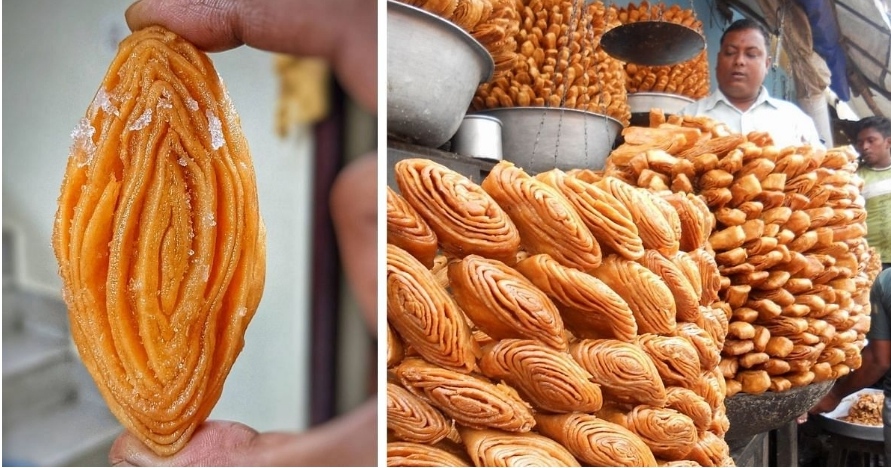What Links Nalanda & Jagannath Puri? A Mithai That Once Wowed Mauryan Emperors

If there’s something that gets a Bengali as excited as a bowl of mach bhat and mangsho (meaning, fish, rice and meat), it’s a prospect for a trip. A community obsession most Bengalis have is to eat and travel – not necessarily in the same order.
One of the places frequented by this community is Puri. A beach city in Odisha, almost every middle-class Bengali family has visited Puri at least once. From pilgrimages and weekend trips to even honeymoons, Puri for decades has seen scores of Bengali tourists.
Having visited Puri more than 10 times, it was always about the food for me. Be it biting on prawn chops (or pakora) sold at the beachside stalls while staring at the sea, or indulging in the flaky crackles of the local delicacy, khaja, a trip to Puri was a true gastronomic adventure.
The city’s true delight, khajas can be found almost everywhere in Puri – from Bada Danda or Grand Road to the entrance of the famous Lord Jagannath temple and is quintessential to the identity of the religious city.
It was quite a surprise then when an Odia friend pointed out that contrary to popular belief, khajas indeed are not indigenous to this state. A little dive into the gastronomic history of khaja reveals multiple origin stories dating back to 320 BCE.
Food for Power Sustenance
Made of wheat, sugar or jaggery, the golden crunchy dessert glistening with syrupy wonder looks a lot like filo pastry or baklava, sans the unique spiral shape. Refined flour is mixed with sugar and converted into a layered dough, which is then shaped into a shell-like pointed spiral, with or without a stuffing. These are then lightly fried in oil or ghee, to get the golden hue and crispy texture.
Before you call it a calorie-dense affair, let’s point out that khaja was termed to be the ‘food for power sustenance’ by none other than Chanakya in the Rigveda and Arthashashtra.
But beyond its physical form, it’s the stories behind it that make the khaja extremely intriguing. With complex textures and multiple origin stories, the seemingly simple dessert khaja is quite unique.
One such theory claims that khaja originated from the eastern parts of Oudh and Agra, making its way to parts of Uttar Pradesh and Bihar. Another emphasises that it originated during the Maurya dynasty in a small village called Silao that lies in between the ancient city Mithila and Nalanda of present-day Bihar.
According to this theory, wheat was one of the most important crops that found prominence in the regional palette during the Mauryan period. Made with wheat flour, this layered sweetmeat was both a symbol of health and sweet indulgence in this region.
Apparently, Chinese traveller, Hiuen Tsang during his explorations in the ancient city of Mithila had come to Silao and encountered khaja, comparing it to the middle-eastern delicacy baklava.
Some reports even mention that Gautam Buddha on his journey from or to Rajgir had stopped near Silao when some locals offered him the sweet. Impressed by it, the spiritual leader then encouraged his disciples to taste it too and make it more popular.
Another piece suggests that archaeologist JD Beglar who visited the area in 1872-73 found some locals mentioning khaja’s origins to be connected to king Vikramaditya. It was Beglar’s research that helped Silao khaja get its GI tag in 2018. Today, this region is a popular spot for travelling foodies looking to stock up on the famous kakinada khaja.

Away from Silao, another interesting reference connects khaja’s origins to South India, specifically Andhra Pradesh-based sweetmeats – gottamkhajas and madathakhajas. While madathakhajas are slightly dry, gottamkhajas are made with ribbons of pastry with a gooey core. Unlike the version found in Silao, these are made with thicker pastry sheets that ensure the exterior is hard and crumbles with a bite. All of these layered sweets are made with wheat.
But beyond the same primary ingredient and similar exterior, there are historical references that tie khajas to South India. According to this report, a 12th-century text Mānasollāsa, also known as Abhilashitartha Chintamani, mentions khajjaka as a sophisticated treat that was often gifted to the royalty.
However, the version for the royals was a little bit more layered in flavours, as bawarchis would prefer to add various aromatic spices like cardamom and clove to the mix.
Making of the Mahabhog of India
By the time khajas came to Odisha and became an integral part of the ‘Chhappan Bhog’ served in the Jagannath Temple since the 12th century, its pastry has undergone several transformations.
For instance, the Odia cooks introduced more layers into their version and moved away from the all-wheat pastry base. Instead, to make the pastry dough they added maida and ghee along with wheat flour. Food expert Minati Parhi says in an article, that the addition of maida enhanced the elasticity of the dough.
“The addition of maida gave that elasticity which could be worked to trap extra moisture and create well-defined layers. It also enabled the easy absorption of the syrup, which initially was made with turning palm jaggery into a maple syrup-like consistency,” she says.
Adding to this in the same article, Chef Ajay Sahoo of The Leela Ambience Gurugram mentions that the unique process of making the dough (called paga) creates moisture packers to trap the air and allow thorough absorption of the syrup. This is what makes a khaja truly divine. The fat-laden ghee locally found in the state creates the right content for the air pockets, they say.
The other important aspects that ensure the humble khaja is elevated to the Mahabhog level is the style of frying, the correct temperature of the oil and the time given to let it rest in the syrup.
Puri’s khajas today are world-famous for their rich and distinct flavour. This can also be credited to the traditional method of resting the khajas on sal patta (sal leaves) after being dipped and coated in the sweet syrup. As the sugar or jaggery is being absorbed, some of it also crystallizes on the surface allowing for a flaky texture, and it does so while being infused with the subtle aroma of the sal patta.
You can find proof of it on your next visit to Puri. Though the city’s ‘Kakatuar dokan’ is an iconic khaja shop, a 36-year-old lesser-known gem near Khaja-patty called ‘Original Nrusingha Sweets’, is a must-visit.
Whatever be the version or origin story of the sweetmeat, with its ghee-glistening crunch, every khaja is an invitation to embrace the complex and layered history of India, steeped in gastronomy and spirituality.



